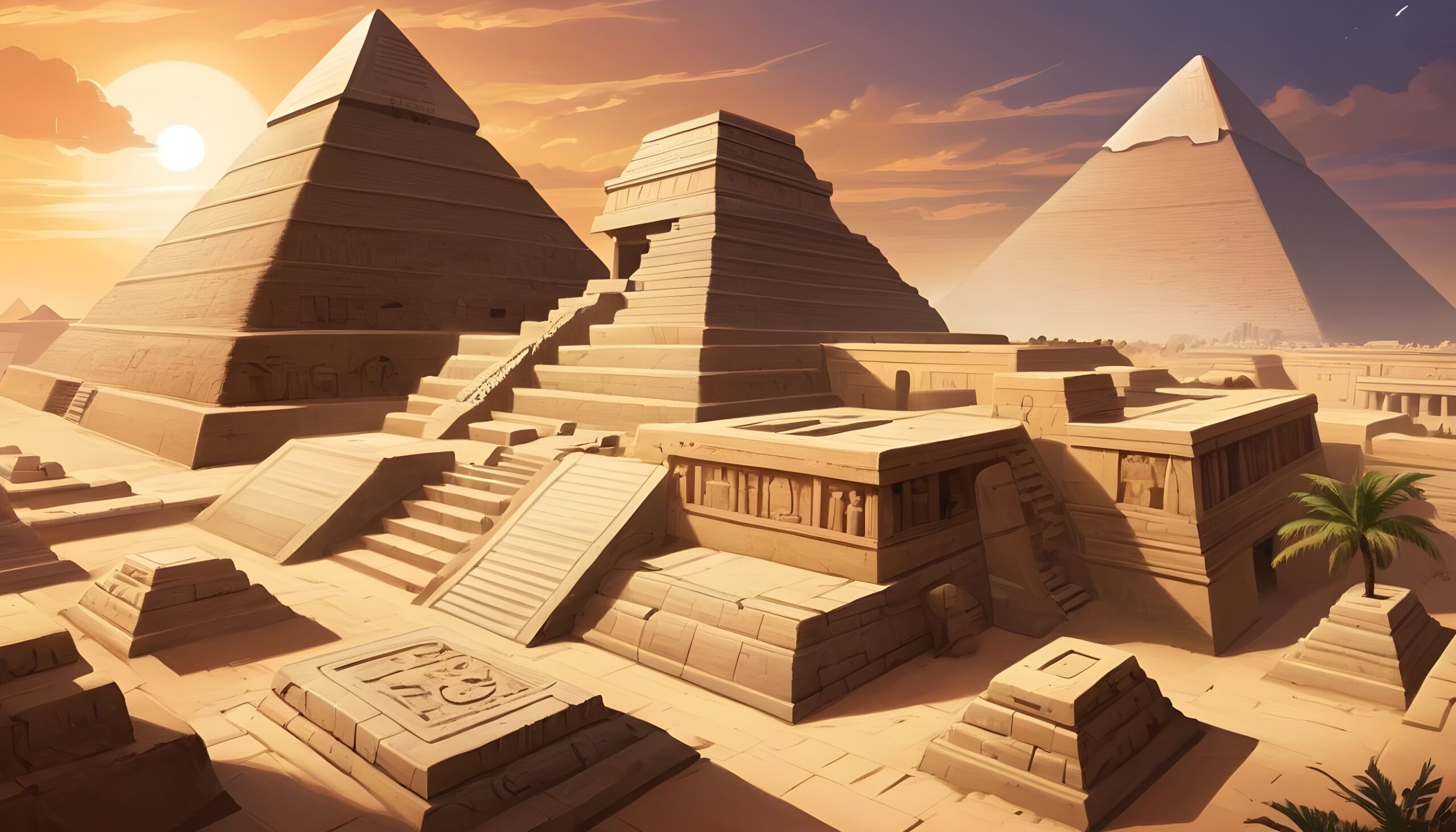Long ago, Egypt was one of the most amazing civilizations in the world. It left a lasting impression on people worldwide. It was located along the Nile River, where powerful kings ruled, grand buildings were constructed, and a rich culture thrived.
The most famous symbols of ancient Egypt are its pyramids. These huge structures, like the Great Pyramid of Giza, were built for the pharaohs, who were believed to have god-like powers.
But Egypt’s treasures aren’t just its pyramids. Their writing, called hieroglyphics, tells us about their lives and beliefs. Understanding this writing helps us learn more about ancient Egypt.
The pharaohs were like kings, but they were also seen as gods. They built big things, fought wars, and led religious ceremonies to keep order in their kingdom.
Religion was very important in ancient Egypt. They worshipped many gods, like Ra, the sun god, Osiris, the god of the afterlife, and Isis, the goddess of magic.
A fascinating part of ancient Egyptian culture was mummification. They preserved bodies after death to ensure a safe journey to the afterlife. They also filled tombs with treasures for the deceased.
As time passed, Egypt faced challenges. It was invaded, and new rulers took over, like Alexander the Great and later the Romans.
But even though ancient Egypt is gone, its legacy lives on. Its wonders continue to fascinate and inspire us today. We’re still learning about this ancient civilization and its mysteries.
The Rise of Ancient Egypt
Ancient Egypt lasted for more than 5,000 years and started along the Nile River. King Menes brought Upper and Lower Egypt together around 3100 BCE, starting the first dynasty. This was a big deal and marked the beginning of Egypt’s first dynasty.
Under King Menes, Egypt had a time of no wars and lots of good stuff happening. Egypt was split into Upper and Lower Egypt, each with its own ways of doing things. But King Menes made them all one, making a strong country that lasted for a long time.
The best time for Egypt was during the Old Kingdom. People built big pyramids during this time, which are still famous today. These pyramids were made to be big tombs for the kings. The Great Pyramid of Giza, for King Khufu, is the most famous one and is still amazing to see.
The kings in ancient Egypt were not just regular rulers; people thought they were gods too. They had all the power and ran everything, like big building projects and trade. They also did religious stuff to make the gods happy.
Religion was really important in ancient Egypt. They believed in lots of gods and goddesses who controlled different parts of life. The main god was Ra, the sun god. Osiris was in charge of the afterlife, and Isis was like a protector for the kings and people.
Even though the Old Kingdom was great, Egypt had some hard times too. The First Intermediate Period was not so good, with fighting and problems with money and society. But Egypt’s ideas and culture stayed strong, helping other civilizations grow later on.
The Pyramids: Marvels of Ancient Engineering
The pyramids in Egypt are amazing structures that show how smart and ambitious the people of ancient Egypt were. The ones at Giza, especially the Great Pyramid, are famous worldwide for how big, precise, and mysterious they are.
The Great Pyramid, built for Pharaoh Khufu over 4,500 years ago, is the biggest and most famous. It’s really tall, about 481 feet (146 meters) high, and was the tallest building in the world for a long time.
Building the pyramids was a huge job that took many years and lots of people. They didn’t have fancy tools like we do now, just simple ones like chisels made of copper, wooden sledges, and ropes. They had to cut big stones from quarries far away and bring them across the desert to build the pyramids.
What’s really cool about the pyramids is how precise they are. Even though they’re gigantic, they’re very symmetrical and aligned perfectly with the compass directions. This is surprising because they didn’t have modern technology back then.
The main reason for building the pyramids was probably for the pharaohs’ tombs. Inside, there are big rooms and passages where the pharaohs were buried with their important stuff. Archaeologists found Khufu’s burial chamber in the Great Pyramid, along with cool things that tell us about ancient Egyptian beliefs about death.
Ancient Egyptians thought that after they died, their soul would go to the gods’ world. So, they built the pyramids to make sure the pharaohs had a safe journey to the afterlife. They did lots of special rituals and mummified the pharaohs’ bodies to preserve them.
The pyramids aren’t just big buildings; they’re symbols of ancient Egypt’s culture and beliefs. They show how much Egyptians respected the gods and believed in life after death. Even today, the pyramids are still impressive and make us think about the mysteries of ancient times.
Pharaohs: Divine Rulers of the Land
The pharaohs of ancient Egypt were like kings, but they were seen as even more special because people thought they were gods on Earth. They had a big job—they had to keep everything in order according to Ma’at, which was like the rules for how the universe worked. They were like middlemen between the gods and the people, making sure everyone got along and things went well in the kingdom.
The main reason why people respected the pharaohs so much was because they believed they were related to the gods. They thought the pharaohs were the gods’ family, so they had special powers and could rule however they wanted.
The pharaohs had a lot of things to do. They were in charge of everything—making laws, running the government, and dealing with other countries. They had a big team to help them with all of this.
But the pharaohs weren’t just rulers; they were also like priests. They did special ceremonies and rituals to keep the gods happy and make sure the kingdom stayed safe and prosperous.
There were many different pharaohs throughout Egypt’s history. Some, like Ramses II, were famous for being really powerful and building lots of big stuff. Others, like Tutankhamun, became famous because of the cool things found in their tombs.
Even though the pharaohs were seen as really important, they still faced the same problems as everyone else. They had to deal with fights, problems in the palace, and sometimes even wars with other countries.
But even though they were mortal like everyone else, the pharaohs left a lasting legacy. Their wisdom and power helped shape Egypt for thousands of years, and people still admire them today for their strength and authority. They were like living symbols of Egypt’s greatness, showing the world what the civilization was all about.
Hieroglyphics: Language of the Gods
Hieroglyphics were the way ancient Egyptians wrote things down. They used these special symbols to tell stories, keep records, and share their beliefs. You could find hieroglyphs on temple walls and in tombs, showing what life was like in ancient Egypt.
Hieroglyphic writing started a long time ago, around 3300 BCE. At first, people drew simple pictures on pottery and stuff. But as time went on, they developed a more complex system with over 700 different symbols. They used hieroglyphs for lots of things, like writing on big buildings, keeping track of stuff, writing religious texts, and even sending letters.
Each hieroglyph represented something specific—a word, an idea, or a sound. Some were easy to understand, like pictures of animals or objects. Others were more abstract, standing for ideas or concepts. By combining these symbols, ancient Egyptians could write down complicated stories and ideas.
For a long time, people couldn’t understand hieroglyphs because they hadn’t been used for so long. But in the 19th century, a guy named Jean-François Champollion figured it out. He looked at the Rosetta Stone, which had writing in three different scripts, and compared them. By matching up the Greek part with the hieroglyphs, he was able to figure out what the symbols meant.
Thanks to Champollion’s hard work, we now know a lot more about ancient Egypt. His discoveries helped other scholars understand and translate tons of ancient Egyptian writing. Today, hieroglyphics help us learn about the fascinating culture of ancient Egypt, even though their spoken language is no longer around. As we uncover more about hieroglyphic writing, we get a better glimpse into the vibrant world of the pharaohs and their people.
Religion: Worship of Ra, Osiris, and Isis
Central to ancient Egyptian religion were three main gods and goddesses: Ra, Osiris, and Isis.
Ra was the sun god, symbolizing light, warmth, and life. Egyptians believed the sun’s journey across the sky was Ra moving, bringing light and vitality to the world. Temples honoring Ra were found all over Egypt.
Osiris was the god of the afterlife and resurrection. He judged the dead in the underworld. According to legend, he was killed by his brother but resurrected by his wife Isis, showing the cycle of death and rebirth.
Isis, the goddess of magic and motherhood, was known for her compassion. She was Osiris’s wife and Horus’s mother. Egyptians saw her as a protector of women, children, and families. Legend says she used her magic to bring Osiris back to life and protect Horus.
These three gods were worshipped in temples and in personal prayers by ancient Egyptians. Their beliefs shaped Egyptian culture for a long time and still fascinate people today.
Mummification: Journey to the Afterlife
The ancient Egyptians had a strong belief in life after death. They saw death as a passage to another world, not the end. One of the most important rituals for them was mummification, a process to preserve the body for the journey to the afterlife. This ritual was very important and showed how much they valued the soul and the body even after death.
Mummification began by carefully preparing the body. Skilled embalmers, called “wrappers of the dead,” removed the organs to prevent decay. They took out organs like the brain through the nose and put them in special jars. Then, they cleaned the body and covered it with natron salts, a substance that dried it out and stopped bacteria from growing. After several weeks of drying, the body was wrapped in linen bandages. This wrapping process could take a long time. They put special charms and amulets in the wrappings to protect the person in the afterlife. Sometimes, they also put a lifelike mask on the person’s face to keep their identity.
During mummification, priests said prayers and performed rituals to honor the person and ask for blessings from the gods. They put food, drinks, and valuable things in the tomb with the person to use in the afterlife. The tomb was filled with furniture, clothes, jewelry, and even pets to make sure the person was comfortable in their new life.
Believing in life after death was a big part of Egyptian life. They thought death was just a new beginning and prepared carefully for it. Mummification was their way of making sure the person had everything they needed for their journey. Today, mummies from Egypt still fascinate people and make them wonder about the mysteries of life and death.
The Fall of Ancient Egypt
Ancient Egypt was once a great civilization known for its impressive achievements and rich culture. But, like all great civilizations, it eventually declined. This decline was a complicated process influenced by many things like fights within the country, attacks from outside, and changes in power worldwide.
The decline of ancient Egypt started after the New Kingdom, a time of great success and growth. Around the late 12th century BCE, powerful pharaohs like Ramses II ruled over a huge empire stretching from the Nile to the Euphrates River. But, over time, problems arose, weakening Egypt’s power.
One big problem was fights and disagreements within Egypt. As the New Kingdom weakened, the pharaohs’ control got weaker too. This led to fights between different regions and leaders, making Egypt unstable.
Outside forces also hurt Egypt. Throughout its history, Egypt faced attacks from other countries wanting its riches and strategic position. Powerful empires like the Assyrians, Persians, and Greeks posed big threats to Egypt’s independence. In 332 BCE, Alexander the Great conquered Egypt, ending native Egyptian rule.
After Alexander’s conquest, Egypt was ruled by the Ptolemaic dynasty, Greek rulers who controlled Egypt for almost 300 years. Despite their rule bringing some stability and growth, internal fights and threats from outside weakened their rule.
The end came when Egypt was conquered by the Roman Empire in 30 BCE after Cleopatra VII and Mark Antony were defeated. Egypt became a Roman province, losing its independence and starting a new era under Roman rule.
Even though ancient Egypt fell, its legacy lives on. The amazing pyramids, mysterious hieroglyphics, legendary pharaohs, and unique mummification rituals continue to fascinate and inspire people worldwide. Remembering the rise and fall of ancient Egypt reminds us of its incredible contributions to art, science, and culture that still matter today.
Legacy of Ancient Egypt
The legacy of ancient Egypt is remarkable and continues to inspire people today. The iconic pyramids, hieroglyphics, and stories of powerful pharaohs all contribute to this enduring legacy. The pyramids, especially the Great Pyramid of Giza, showcase the Egyptians’ architectural and engineering skills. Hieroglyphics offer insights into their beliefs and daily life. The pharaohs, like Ramses II and Hatshepsut, left behind tales of grandeur and ambition. Religion was central to Egyptian life, with gods like Ra, Osiris, and Isis worshipped fervently. Overall, ancient Egypt’s impact on human history is profound, and its mysteries continue to fascinate and captivate people worldwide.










More Stories
Alexander the Great: A Legacy Unparalleled
The Mauryan Era: India’s first great empire
Battle of Verdun: The Longest Battle of World War I